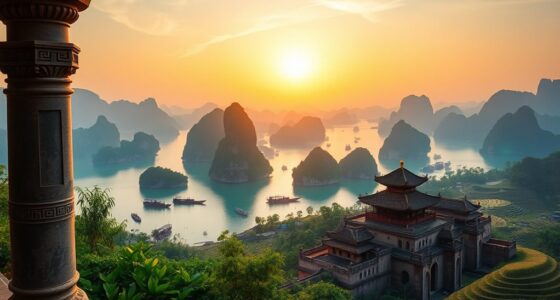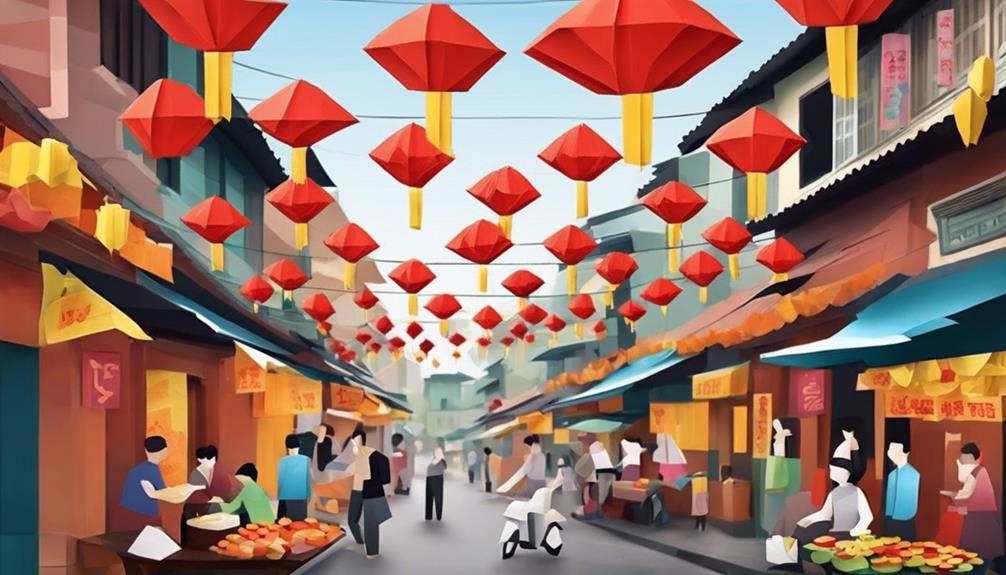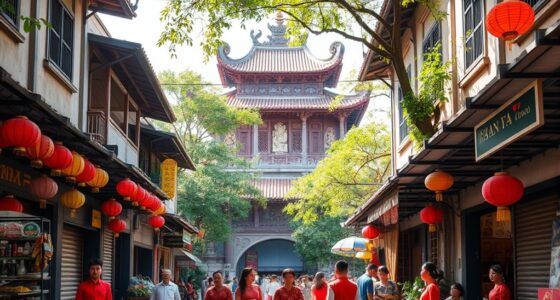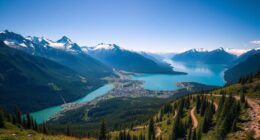Vietnam offers an exciting mix of bustling cities like Hanoi and Ho Chi Minh City, stunning natural wonders like Ha Long Bay, and historic sites such as Hoi An and Hue. You can enjoy vibrant markets, delicious street food, and adventure activities like caving and trekking. Entry is easy with e-visas and expanded visa waivers, while the best times to visit vary by region. Keep exploring to uncover all the tips for your unforgettable trip.
Key Takeaways
- Explore top destinations like Hanoi, Ho Chi Minh City, Ha Long Bay, Hoi An, and Phong Nha-Ke Bang for diverse experiences.
- Utilize Vietnam’s simplified e-visa system and expanded entry points for hassle-free travel.
- Immerse yourself in rich cultural experiences through markets, festivals, and authentic cuisine like pho and banh mi.
- Enjoy eco-tourism activities such as cave exploration, trekking, kayaking, and mountain biking in scenic national parks.
- Travel during optimal seasons (Sept-Nov, Feb-April, Dec-April) and book accommodations early during peak periods.
Top Destinations and Must-See Attractions

Vietnam offers a diverse array of top destinations and must-see attractions that cater to every traveler’s interests. You’ll want to explore Hanoi’s vibrant streets, rich history, and tasty street food, while Ho Chi Minh City buzzes with energy, modern markets, and historic sites. Natural wonders like Ha Long Bay wow visitors with limestone karsts and crystal-clear waters, perfect for cruises and kayaking. In Central Vietnam, Hoi An’s ancient town charms with lantern-lit streets and traditional architecture, and Hue’s imperial ruins reveal Vietnam’s royal past. For adventure seekers, Phong Nha-Ke Bang offers stunning caves and lush national parks. Whether you prefer cultural immersion, nature exploration, or urban excitement, Vietnam’s diverse destinations promise unforgettable experiences at every turn. Incorporating safety precautions and proper planning can enhance your trip and ensure a smooth, enjoyable journey.
Navigating Entry and Visa Policies

Managing entry and visa policies in Vietnam has become easier and more flexible, thanks to recent reforms that streamline the process for travelers. You can now apply for an e-visa online, which grants up to 90 days of multiple entries, making planning your trip more convenient. The visa waiver list expanded in 2025 to include 24 European countries, allowing stays of up to 45 days without a visa. Entry points have increased to 42 international checkpoints, simplifying arrivals by air, land, or sea. There’s no waiting period between visa-exempt entries, so you can re-enter immediately if eligible. Pending reforms aim to offer longer-term residency options for investors and professionals, further easing the path for those planning extended stays or business visits. Support hours for consular services and visa processing are available at various embassies and online, ensuring assistance when needed.
Cultural Experiences and Local Cuisine
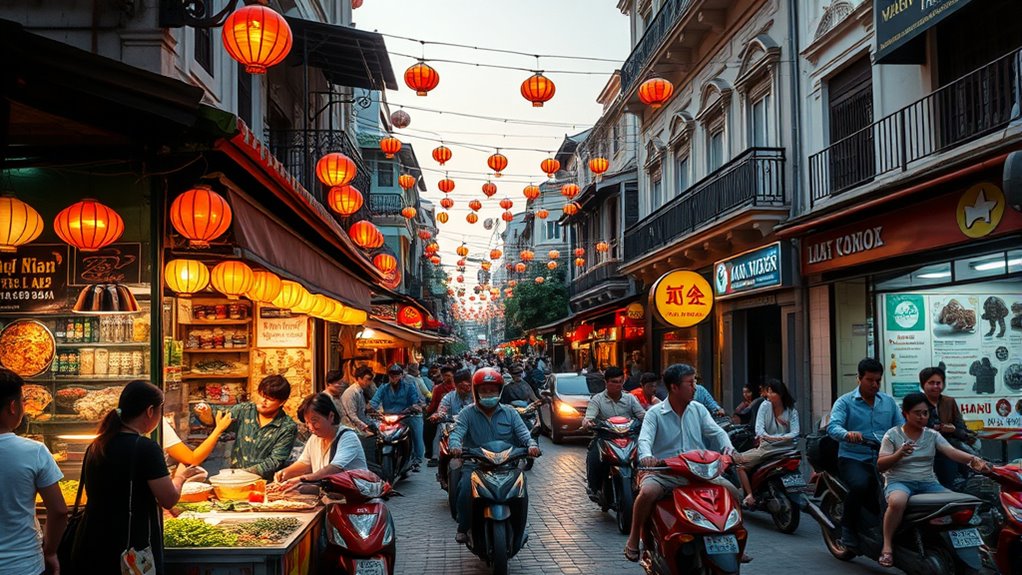
Exploring Vietnam’s rich cultural tapestry offers travelers an immersive experience that goes beyond sightseeing. You’ll encounter vibrant markets, traditional festivals, and centuries-old temples that tell stories of the nation’s history. Savor local cuisine by trying iconic dishes like pho, banh mi, and fresh spring rolls, each bursting with unique flavors. In cities like Hanoi and Ho Chi Minh City, street food stalls serve up authentic tastes that reflect regional traditions. Participate in local customs, from tea ceremonies to lantern festivals, to deepen your connection with Vietnamese culture. Handcrafted textiles, pottery, and art galleries showcase Vietnam’s artistic heritage. The use of self-watering plant pots in traditional Vietnamese homes and gardens highlights an innovative approach to maintaining greenery. Embrace the lively atmosphere, warm hospitality, and diverse traditions that make Vietnam’s cultural experiences truly unforgettable.
Eco-Tourism and Adventure Activities
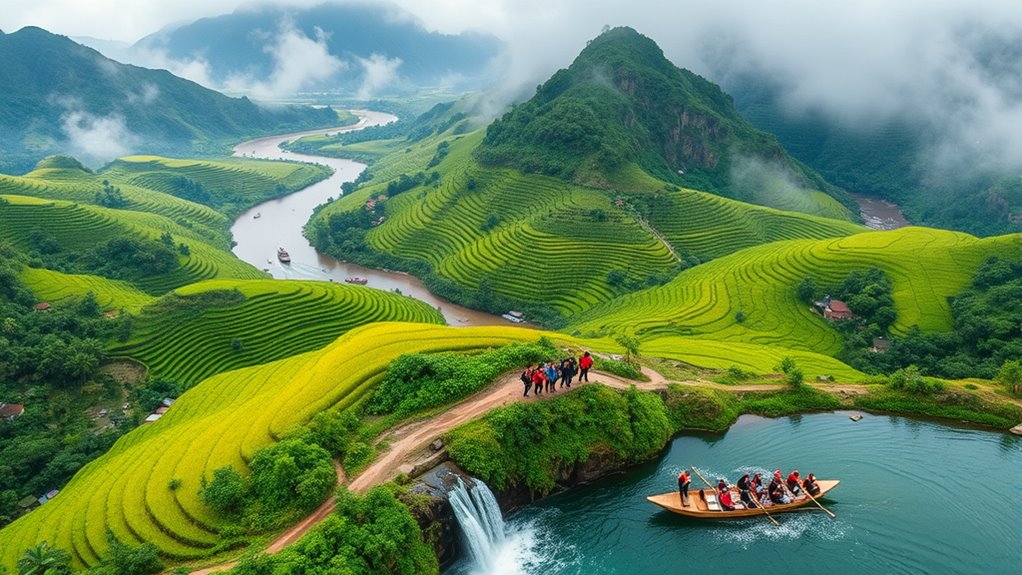
As eco-tourism and adventure activities gain popularity, travelers are increasingly drawn to Vietnam’s stunning natural landscapes and untouched environments. You can explore the breathtaking Phong Nha-Ke Bang National Park, famous for its impressive caves and lush forests, perfect for caving and trekking. In Sapa, you’ll find scenic hikes through terraced rice fields and mountain villages, offering authentic cultural immersion. Kayaking and boat tours around Ha Long Bay let you marvel at limestone karsts and clear waters, ideal for eco-friendly exploration. For adrenaline junkies, mountain biking in Da Lat and zip-lining in Ba Na Hills deliver exciting outdoor experiences. These activities not only satisfy your sense of adventure but also promote sustainable tourism, helping preserve Vietnam’s natural beauty for future generations. The aroma of the natural environment in these areas enhances the overall experience, reminding visitors of the importance of conservation efforts.
Best Times to Visit and Seasonal Tips

The best time to visit Vietnam depends largely on the region and your preferred activities, as the country experiences distinct seasonal patterns. In the north, visit from September to November or March to May for mild weather. Central Vietnam is best from February to April to avoid typhoons. The south remains warm year-round, with dry season from December to April. Embracing limits on creativity can also inspire unique travel experiences and solutions during your trip.
Practical Travel Tips and Infrastructure Insights

Planning your trip to Vietnam involves practical considerations that can make your journey smoother and more enjoyable. Here are four essential tips to keep in mind:
- Use the e-visa system—it’s expanded and allows multiple entries for up to 90 days, saving you time and hassle.
- Choose the right entry point—with 42 international checkpoints, select airports or borders with convenient connections to your destinations.
- Book accommodations early—rising tourism means higher prices and limited availability, especially during peak seasons.
- Learn basic local phrases—it builds rapport, eases communication, and enriches your experience.
– Additionally, understanding the infrastructure improvements can help you navigate more efficiently and enjoy a smoother travel experience.
Vietnam’s infrastructure is rapidly improving, making travel easier, but preparation guarantees you avoid unnecessary stress. Embrace these tips, and your adventure will start on the right foot.
Frequently Asked Questions
What Are the Latest Safety Regulations for Travelers in Vietnam?
You should check current safety regulations before your trip to Vietnam, as rules may change. Make certain you have a valid visa or e-visa, follow local health guidelines, and adhere to COVID-19 protocols, such as mask-wearing and social distancing if required. Be cautious with your belongings, avoid risky areas, and stay updated on travel advisories from your government. Respect local customs and laws to ensure a safe and smooth visit.
How Can Travelers Find Affordable Accommodation Options Across Vietnam?
You can find affordable accommodation options across Vietnam like hunting for hidden gems in a bustling market. Budget hostels, guesthouses, and homestays are plentiful, especially in cities like Hanoi and Ho Chi Minh City. According to recent data, travelers spend a median of just a few dollars per night on budget stays. Use local booking sites, consider staying in less touristy neighborhoods, and always read reviews to score the best deals.
Are There Any Local Customs I Should Be Aware Of?
You should be aware of respecting local customs to enjoy your trip. Greet people with a slight bow or handshake, and avoid pointing your feet at people or religious objects. Dress modestly when visiting temples or pagodas, and remove shoes before entering. Show politeness by using both hands when giving or receiving something. Be mindful of local traditions during festivals, and always ask before taking photos of locals or their property.
What Healthcare Facilities Are Available for Tourists?
A healthy traveler is a happy traveler, so you’ll find modern healthcare facilities readily available in Vietnam’s major cities. Public and private hospitals in Hanoi, Ho Chi Minh City, and others offer quality care, often with English-speaking staff. Pharmacies are widespread, and clinics cater to tourists’ needs. While minor issues are easily managed, for serious conditions, international hospitals guarantee you get the best treatment without hassle.
How Do I Access Reliable Transportation Within Cities?
You can access reliable transportation within cities by using ride-hailing apps like Grab, which are widely available and affordable. Taxis are also available, but make certain they use meters or agree on a fare beforehand. Public buses are economical, though they may be crowded and less tourist-friendly. Renting a motorbike or bicycle is another option for flexible, local travel, but always prioritize safety and local traffic laws.
Conclusion
Now that you have this ultimate guide, you’re ready to explore Vietnam’s vibrant culture, stunning landscapes, and unforgettable adventures. Will you embrace the local traditions, savor every flavor, and leave with stories to tell? Remember, traveling isn’t just about seeing new places—it’s about experiencing them fully. So go ahead, step out of your comfort zone, and make your journey in Vietnam truly unforgettable. Are you ready to create memories that will last a lifetime?



